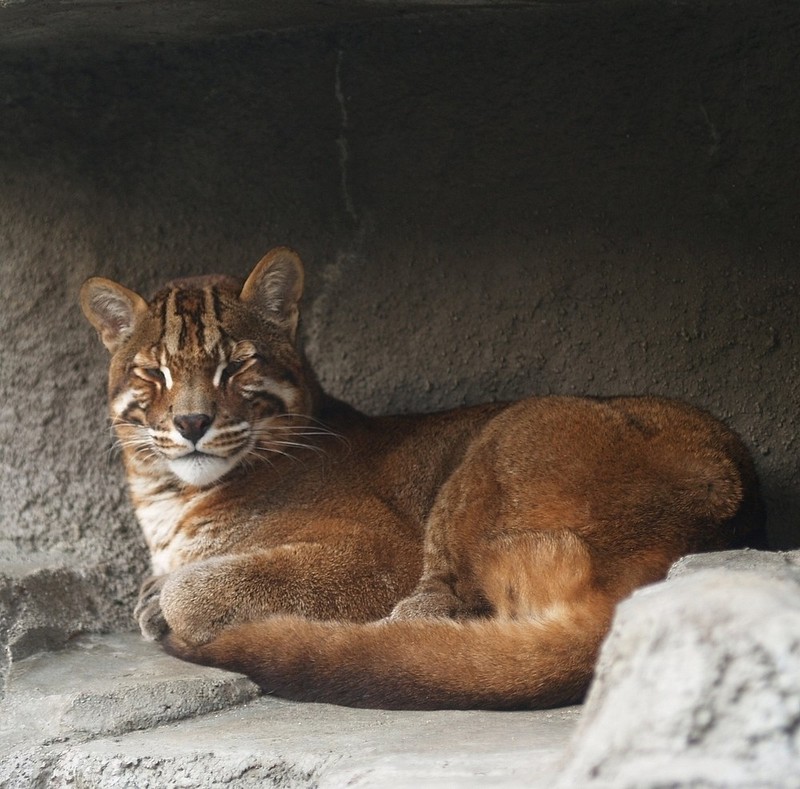|
Asian Golden Cat (Pardofelis temminckii) - Wiki
| 제목: | Asian Golden Cat (Pardofelis temminckii) - Wiki
| |

| 해상도: 1000x986
파일크기: 225997 Bytes
촬영일: 2006:12:03 15:50:27
사진기: E-300 (OLYMPUS IMAGING CORP. )
F number: f/1.0
Exposure: 1/20 sec
Focal Length: 0/10
등록시간: 2007:11:02 11:29:21
|
Asian Golden Cat
From Wikipedia, the free encyclopedia
[Photo] Asian Golden Cat (Pardofelis temminckii). Source: Source http://opencage.info/pics/large_7636.asp Date: 3 December 2006. Author OpenCage (http://commons.wikimedia.org/wiki/User:Opencage)
The Asian Golden Cat (Pardofelis temminckii, previously been placed in genera Catopuma, Profelis and Felis), also called the Asiatic Golden Cat and Temminck's Golden Cat, is a medium-sized wild cat (length 90 centimetres/36 in, plus 50 centimetre/20 in tail) weighing from 12 to 16 kilograms (26 to 35 lbs). In captivity this species can live up to 20 years, but its average lifespan in the wild is likely far shorter. While the fur is mostly foxy red or golden brown, black or grey colour variants may also be found. Normally, the coat is plain, save for some spots on the underside, and sometimes very faint spotting on the rest of the coat. However, in China there is a colour variant with leopard-like spots, which resembles a Leopard Cat. This spotted fur is a recessive characteristic, i.e. when a spotted and a plain cat interbreed, the young get plain fur.
Distribution and habitat
The Asian Golden Cat lives throughout Southeast Asia, ranging from Tibet and Nepal to Southern China, India, and Sumatra. It prefers forest habitats interspersed with rocky areas, and is found in deciduous, subtropical evergreen, and tropical rainforests. The Asian Golden Cat is occasionally found in more open terrain. It ranges from the lowlands to altitudes of up to 3000 meters in the Himalayas.
Behavior
Not much is known about this rather elusive predator, and most of what is known about it has been found out in captivity. Previous observations suggested that it is primarily nocturnal, but a recent study on two golden cats showed arrythmic activity patterns. It is thought to be primarily solitary. As far as vocalizations go, it can hiss, spit, meow, purr, growl, and gurgle. Other methods of communication observed in captive golden cats include scent marking, urine spraying, raking trees and logs with claws, and rubbing of the head against various objects.
Hunting habits
The Asian Golden Cat prefers to hunt on the ground, but does climb when it needs to. When hunting, it uses a stalk and rush method typical of felines. It is known to hunt birds, lizards, rodents, other small mammals, and the occasional small or young deer, and seems to be fairly adaptable in its diet. The Asian Golden Cat has been reported to hunt in pairs when pursuing larger animals. In captivity, it plucks the feathers of larger birds before eating them. There have been reports of the Asian Golden Cat scavenging, a behavior not commonly seen in felines. Rarely, it hunts near human settlements or prey on livestock.
Reproduction
Everything known about Asian Golden Cat reproduction has been figured out from observations of them in captivity. It becomes sexually mature at anywhere from eighteen to twenty-four months of age. Its gestation period lasts about 80 days; litters usually consist of only one kitten. Kittens are born in the hollows of trees, rock crevices, and possibly in hollows and other sheltered places on the ground. The pelts of kittens are thicker and slightly darker, but with the pattern they will keep for their entire life. Based on what has been seen in captivity, it is thought that males take an active role in rearing the young.
Mythology
In some regions of Thailand the Asian Golden Cat is called Seua fai ("fire tiger"). According to a regional legend the burning of an Asian Golden Cat's fur drives tigers away. Eating the flesh is believed to have the same effect. The Karen tribe believes that simply carrying a single hair of the cat will be sufficient. Many indigenous people believe this cat to be fierce, but in captivity it has been known to be very docile and tranquil.
Subspecies and conservation
The exact population of the Asian Golden Cat is unknown, but it is listed on "CITES: Appendix I" and as "Lower Risk/Near Threatened" by the IUCN. It is hunted for its fur and, increasingly, for its bones in traditional Chinese medicine. However, the greatest risk posed towards the species is habitat destruction. There are few of these felines in zoos, and they do not breed well in captivity.
There are three known subspecies:
Pardofelis temminckii temminckii, Himalaya, Southeast Asian mainland, Sumatra
Pardofelis temminckii dominicanorum, southeast China
Pardofelis temminckii tristis, southwest China
http://en.wikipedia.org/wiki/Asian_Golden_Cat
| The text in this page is based on the copyrighted Wikipedia article shown in above URL. It is used under the GNU Free Documentation License. You may redistribute it, verbatim or modified, providing that you comply with the terms of the GFDL. |
|
^o^
동물그림창고 똑똑전화 누리집
^o^
|
|

